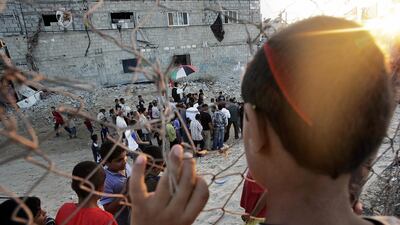At one point in this well-crafted study of one of the world's most densely populated places, Donald Macintyre seeks out the first man he met in the Palestinian enclave 14 years previously.
A kind of Gazan everyman, Mahmoud Al Bahtiti is a car mechanic who has observed things change but nothing improve from the doors of his lock-up.
In 2003 he subversively told Macintyre that Yasser Arafat’s post-Oslo authority would transform Gaza into the Singapore of the Middle East. In the interim, he moved premises once, only to end up next to the Hamas-run Ministry of Interior, which was bombed in 2012. Back in the original street in 2016, his business somehow survived a lack of demand and constant power shortages.
Was he angry when the lights failed? The shortages were designed to keep Gaza in an economic netherland. “They can cut it as much as they like,” he says. “Gaza is like heaven. There is no work in heaven either.”
A former British political correspondent, Macintyre abruptly changed direction late in his career to spend more than a decade living in Jerusalem. He has now produced a loving, if at times angry, chronicle of his work in Gaza over those years.
As the title Gaza Preparing for Dawn suggests, Macintyre finds great resilience among the besieged. A passage of the book is enlivened by the artist Maha Al Daya and her husband Ayman Eissa. She refuses to succumb to the temptation of incorporating war and conflict in her work. Instead, her land and seascapes chronicle an ever-changing city and its coast.
Then there are the teenagers who marked the 400th anniversary of Shakespeare by staging King Lear in the Nuseirat refugee camp in faultless English.
In his interviews for the book, Macintyre secures from his old contact Tony Blair, who was an envoy of the Quartet, a concession that it was wrong to isolate Gaza after Hamas won the 2006 election. In fact, Gaza has been bombarded for 100 years. In his chat with Bahtiti, Macintyre is presented with a demand from his protagonist that Britain apologise for the Balfour Declaration, issued a century ago last week. As that fateful document emerged, Macintyre points out that the British Expeditionary Force under General Edmund Allenby took Gaza City just five days after Balfour dispatched his memo to Lord Rothschild.
It is the inexorable events that came in the wake of the 2003 Iraq War and the democracy agenda of US president George W Bush that Macintyre is closest to. He provides perspective from the hotels where diplomacy is conducted, to the bombed-out streets where Gazans struggle in survival mode.
The pivotal moment was Ariel Sharon's repudiation of the Quartet's "road map". Macintyre brings us inside the Rome hotel when Sharon told Elliot Abrams, US deputy national security adviser, of his unilateral evacuation of the Israeli settlements in Gaza. His argument was demographic. Israel's 5.4 million Jews were just greater in number than the 4.6 million Palestinians. To secure the homeland, Israel would retreat.
_____________________
Read more:
Book review: Mary Beard's newest novel explains why trolls are just ancient misogynists
Nigerian and British crime fiction under the spotlight at the Sharjah International Book Fair
Book review: The Butchering Art tells tale of how Joseph Lister revolutionised modern medicine
_____________________
It would not stop its interference. Rocket attacks and assassinations resulted in the deaths of a succession of Hamas leaders, including Sheikh Ahmed Yassin and Abdel Aziz Rantissi. Such incidents became the waypoints of what was to become a deepening conflict.
In Gaza Preparing for Dawn, the wars against the enclave are vividly described but its most acute moments are the personal stories that Macintyre unearths. There is the euphoria among residents of Khan Yunis in September 2005, when they were able to run along the beach that only a day earlier had been forbidden territory. Barely a year later there is panic among Fatah as Mohammed Dahlan realises the political runes are wrong and seeks in vain to postpone the vote so that the establishment can regroup.
As the last Gazans are barred from earning a living in Israel, a practice that dated back to the 1960s, one man tearfully tells Macintyre of his anguish as his son asked for spending money.
We meet Nisrin Jilo, a mother who was deported from Qalqilya in the West Bank where she had lived since she was nine. An Israeli soldier inspected her Gazan ID in 2007 and she was immediately sent back, separating her from her two children.
Even the fiction that Macintyre reads captures the desolate present. He recalls a story about a girl visited in hospital by her uncle from Kuwait. The uncle says he has brought the red trousers she asked for as a present. The girl Nadia tearfully points to her amputated leg.
At the time of writing, there is at last political movement between the Palestinian state and Hamas that has allowed the return of a unitary authority. Macintyre unearths a 2005 Rand Corporation report that paints Gaza as a modern metropolis trading with the world.
As once its seaport sent barley and wheat across the Mediterranean, so a futuristic plan could see it trading with the world. Gazans, quotes Macintyre, will always choose economic freedom over aid dependency. If they can.

